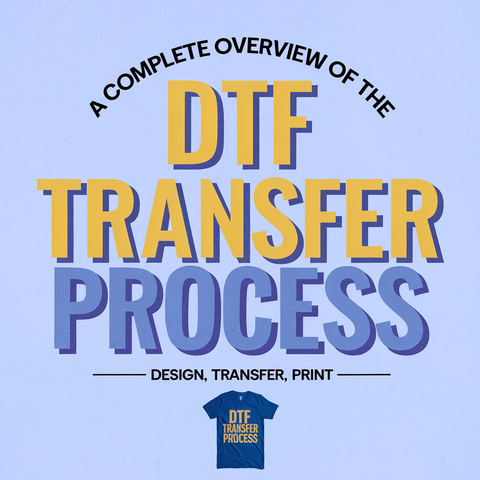Frequently Asked Questions
1. What is DTF Printing?
2. Why should I choose DTF Transfers over other methods?
3. What are the main steps in the DTF transfer process?
4. How can I maintain the quality of DTF transfers?
5. What common challenges might I face with DTF transfers?
If you're diving into the world of custom apparel or promotional items, understanding the Direct to Film (DTF) transfer process is essential. This method has surged in popularity due to its flexibility and high-quality results. In this article, we'll explore the complete DTF transfer process, covering everything from the initial design to the final application. Whether you're a budding entrepreneur or an established business owner, this guide will provide the knowledge you need to excel with DTF transfers.
What is DTF Printing?
DTF printing refers to the process of printing designs onto a specialized film and then transferring those designs onto various fabrics using heat and pressure. This technology has revolutionized the way we approach custom prints, offering several advantages over traditional methods like screen printing and vinyl transfers.
Why Choose DTF Transfers?
DTF transfers have become a favorite among businesses for several reasons:
- Versatility: DTF transfers can be applied to a wide variety of fabrics, including cotton, polyester, and blends.
- Vibrant Colors: The process allows for high-quality prints with bright colors that stand out.
- Complex Designs: DTF printing effectively captures intricate designs and fine details.
- Soft Feel: Unlike some other methods, DTF transfers maintain a soft feel on the fabric.
- Easy Application: The application process is simple and does not need complex setups.
Understanding the DTF Transfer Process
Now that we've established what DTF transfers are and why they are beneficial, let's break down the process. Understanding each stage is critical for ensuring that your prints are of the highest quality. Here’s how it works:
Step 1: Creating the Design
The first step in the DTF transfer process is designing your artwork. This is where creativity shines. Here are some tips to keep in mind:
- Use high-resolution images to ensure clarity and detail.
- Design for the intended fabric color. Dark fabrics may require additional considerations for visibility.
- Consider the size of the print based on the item you’ll be transferring onto.
Step 2: Preparing the DTF Gang Sheet Upload
Once your design is ready, the next phase is preparing the gang sheet. This involves laying out multiple designs on a single sheet to optimize the printing process. Here's how to do it effectively:
- Arrange your designs close together to make the best use of the film.
- Leave ample margin around each design to ensure clean cuts.
- Double-check the dimensions before uploading for printing to prevent any scaling issues.
Step 3: Printing the Transfer
After preparing your DTF gang sheet upload, it's time to print. The right printer is crucial at this stage. Here’s what to consider:
- Use a DTF-specific printer that can handle high-quality color prints.
- Ensure you're using the correct inks, as they are designed specifically for the DTF process.
- Monitor the settings to achieve the best results. Adjust the ink levels for vibrant colors.
Step 4: Applying the Adhesive
Once printed, the next step is to apply a special adhesive to the printed design. This ensures that the design adheres properly to the fabric during transfer. Here's how to do it:
- Sprinkle the adhesive evenly over the printed design while it’s still wet.
- Use a heat press or powder shaker to ensure an even distribution.
- Remove any excess powder carefully.
Step 5: Curing the Adhesive
After applying the adhesive, it’s time to cure it. This step is crucial for ensuring that the ink adheres well to the film. Follow these tips:
- Cure the prints in a heat press for a specific duration and temperature as recommended by your adhesive's manufacturer.
- Allow prints to cool before moving to the next step to avoid smudging.
Step 6: The Transfer Process
Now, we reach the climax of the DTF transfer process—application to the fabric. Here’s how to ensure a perfect transfer:
- Preheat the fabric you’ll be applying the design onto to remove any moisture.
- Position the DTF transfer on the fabric, ensuring proper alignment.
- Use a heat press to apply pressure and heat for the specified time, usually around 15-20 seconds.
- Allow the transfer to cool for a moment before peeling the film away gently.
Step 7: Final Touches
After the transfer is complete, it’s essential to implement a few finishing touches:
- Inspect your print for any imperfections.
- If needed, reheat the design to ensure durability.
- Advise customers on the best care practices to maintain the quality of the print over time.
Maintaining Quality in DTF Transfers
To ensure the longevity of your DTF transfers, proper maintenance and care of both the prints and the equipment is vital. Let’s look at some best practices:
Caring for DTF Transfers
- Advise customers to wash the garments inside out in cold water.
- Avoid using bleach and harsh detergents on DTF printed items.
- Recommend air drying to maintain the quality of the print.
Maintaining Your Equipment
Keeping your machinery in top shape will lead to better quality prints. Here are some pointers:
- Regularly clean your printer heads to avoid clogs.
- Check and calibrate your equipment settings to ensure accurate prints.
- Replace inks and consumables as needed to avoid inconsistencies.
Common Challenges and Solutions
Like any printing method, DTF transfers come with their share of challenges. Here are some of the common issues you might encounter and some solutions:
Issue 1: Poor Adhesion
If you're experiencing issues with the design peeling off, it could be due to inadequate curing of the adhesive or incorrect application techniques. Ensure you are following the right process carefully and conducting test runs to find the optimal settings.
Issue 2: Color Mismatch
Sometimes colors may not appear as vibrantly as expected. Always use high-quality images and calibrate your printer settings before running large batches. Undertake test prints to adjust colors as necessary.
Issue 3: Print Quality
Blurry or pixelated designs can be frustrating. Always start with high-resolution images, and keep the printer clean and maintained for the best quality output.
Getting Started with DTF Transfers
If you’re ready to take the plunge and start your journey with DTF transfers, then establishing a plan is vital. Begin gathering the necessary equipment and materials:
- DTF Printer: Invest in a reliable DTF printer suited for your production needs.
- Heat Press: A good heat press is essential for transferring designs.
- Inks and Adhesives: Purchase high-quality inks and specific adhesives designed for DTF.
- Transfer Film: Make sure to use the appropriate film essential for the DTF process.
Final Thoughts: Unlocking Your Creative Potential
Understanding the DTF transfer process opens a world of possibilities for custom apparel and merchandise. By mastering the steps outlined in this article—from designing your prints to executing the transfer—you set your business up for success. DTF transfers not only enhance your product offerings but also allow you to express creativity in lucrative ways. Keep experimenting with designs and techniques, and watch as your custom creations shine in a competitive market!


